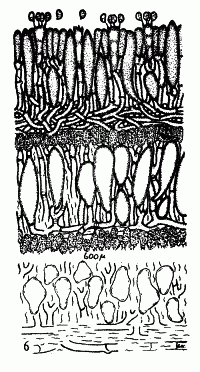|
 Corticium perenne Corticium perenne
BiostatusPresent in region - Indigenous. Endemic
Images (click to enlarge)
Caption: TEXT-FIG. 6. Corticium perenne. x 500. |
Article: Cunningham, G.H. (1954). Thelephoraceae of New Zealand. Part III: the genus Corticium. Transactions of the Royal Society of New Zealand 82(2): 271-327.
Description: Hymenophore perennial, stratose, membranous-coriaceous, closely adnate, forming linear
areas to 20 x 3 cm.; surface white, becoming pallid cream, even, sparsely creviced when old;
margin receding in each successive layer, white, adnate, arachnoid, black creviced and
vernicose where long exposed. Context 2-2.5 mm. thick, cream or isabelline, composed of
30-40 brown-tinted layers each 50-130 µ deep, of densely packed mainly vertical hyphae with
narrow bands of parallel hyphae and crystals or crystal-coated hyphae between; generative
hyphae 2-31 µ diameter, wall 0.2 µ thick, hyaline, branched, septate, with clamp connections.
Hymenial layer of basidia, paraphyses and gloeocystidia, to 25 µ deep. Basidia subclavate,
16-20 x 4-6 µ, 4-spored; sterigmata slender, to 4 µ long. Paraphyses subclavate, about half
the length of the basidia. Gloeocystidia arising near the base of each layer, fusiform or
clavate, 30-40 x 8-12 µ, not projecting, wall 0.5-1 µ thick. Spores pip-shaped, a few
suballantoid, 3.5-5 x 2-3 µ, apiculate, wall smooth, hyaline, 0.2 µ thick.
Habitat: HABITAT. Effused on decorticated wood.
Distribution: DISTRIBUTION. New Zealand.
Notes: Recognized readily by the thick perennial hymenophore composed of as many as 40 layers,
visible under a lens. Each layer consists of a palisade of gloeocystidia and is demarked at the
base by masses of crystals tinted brown coating the ends of context hyphae and paraphyses or
lying between them. From the current hymenium to the base there is progressive deterioration
through gelatinization of walls of hyphae and gloeocystidia; consequently towards the base
only a few hyphal remnants are discernible as such and the position of gloeocystidia indicated
by cavities of irregular size and shape. Layers are not equal in width but may range from 50 to
130 µ in depth, and sometimes merge at intervals.
Article: Stalpers, J.A. (1985). Type studies of the species of Corticium described by G.H. Cunningham. New Zealand Journal of Botany 23(2): 301-310 (http://www.rsnz.org/publish/abstracts.php).
Notes: In addition to Cunningham's description the type specimen shows some clavate to acuminate
Cystidia, up to 70 µm long. Additional material is needed to ascertain the taxonomic position
of this peculiar species.
|